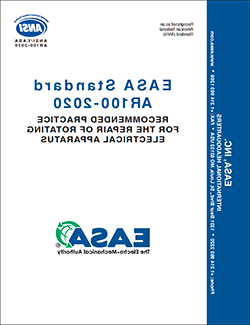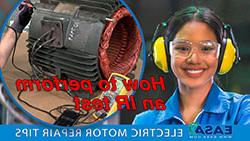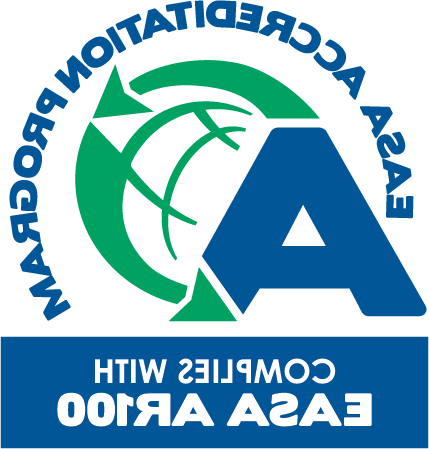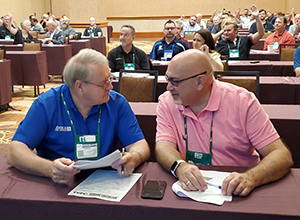What To Consider When Deciding to Repair Premium Motors
Is it better to repair or replace an electric motor that fails? For most plant engineers and maintenance staff, experience attests to the reliability of standard efficiency motors that have been repaired or rewound using industry best practices. Repair also can cost far less than replacement, especially if the motor has special features.
But some decision makers opt to replace failed premium efficient motors because they’ve “heard” these motors can’t be repaired without a loss of efficiency.
So, what’s the right answer? It turns out that the decision to repair, rewind or replace a failed premium efficient motor is not always so simple and straightforward as you may have heard.
Read the complete article by Tom Bishop, P.E., EASA Senior Technical Support Specialist, at Plant Engineering.
The 2019 Rewind Study
 The Effect of Repair/Rewinding on Premium Efficiency/IE3 Motors
The Effect of Repair/Rewinding on Premium Efficiency/IE3 Motors
Published: January 2021
In response to various opinions about the feasibility of maintaining motor efficiency during repair, including replacement of the stator winding, the Electrical Apparatus Service Association (EASA) and the Association of Electrical and Mechanical Trades (AEMT) conducted two comprehensive rewind studies using third-party testing laboratories. This study was a follow up to a similar study conducted 2003. This valuable publication explains the findings:
The 2019 study reaffirms the results of the 2003 study.
Motors can be repaired without reducing efficiency.
LEARN MORE & DOWNLOAD FOR FREE BUY PRINTED COPIES
Good Practice Guide To Maintain Motor Efficiency
 Published: January 2021
Published: January 2021
The original 2003 rewind study good practice guide has been editorially updated, with no substantive changes to any of the good practices. Intended primarily for service center personnel, the guide which is now an independent document and not part of the complete EASA/AEMT rewind study report, outlines the good practice repair methods used to achieve the results given in both studies. It contains repair tips, relevant motor terminology, and information about sources of losses in induction motors that affect efficiency.
ANSI/EASA AR100-2020: Recommended Practice for the Repair of Rotating Electrical Apparatus
 Published: September 2020
Published: September 2020
EASA’s “Recommended Practice for the Repair of Rotating Electrical Apparatus” is designated ANSI/EASA AR100 and was first approved as an American National standard in 1998. Since then it has been revised and approved four more times, in 2001, 2006, 2010, 2015 and now in 2020.
ANSI/EASA AR100 is a must-have guide to the repair of rotating electrical machines. Its purpose is to establish recommended practices in each step of the rotating electrical apparatus rewinding and rebuilding processes.
The scope of this document describes record keeping, tests, analysis and general guidelines for the repair of induction, synchronous and direct current rotating electrical apparatus. It is not intended to take the place of the customer's or the machine manufacturer's specific instructions or specifications or specific accepted and applicable industry standards or recommended practices.
This document should be supplemented by additional requirements applicable to specialized rotating electrical apparatus including, but not limited to, listed explosion-proof, dust-ignition proof, and other listed machines for hazardous locations; and specific or additional requirements for hermetic motors, hydrogen-cooled machines, submersible motors, traction motors, or Clas 1E nuclear service motors.
ANSI recognizes only one standard on a topic; therefore, the EASA Recommended Practice is the standard for repair of rotating electrical apparatus.
Guidelines for Maintaining Motor Efficiency During Rebuilding
Published: November 2007
This article provides guidelines that service centers can follow to retain the operating efficiency of the electric motors they rewind and rebuild. It includes a list of "do's and don'ts", safe values and correct procedures based on studies of variables that can impact the efficiency of rewound electric motors (core burnout temperature, winding design, bearing type, air gap, winding resistance, etc).
This article was first published in May 1992; reviewed and revised as necessary in November 2007 by EASA's Technical Services Committee.
Can you repair energy-efficient motors? Maybe.
An EASA-authored article that appeared on the Canadian Forest Industries website — www.woodbusiness.ca
Most plant engineers and maintenance staff can attest to the reliability of standard-efficiency motors that have been repaired or rewound using industry best practices. They also know repair can cost far less than replacement, especially when the motor has special features. Despite this, some of them hesitate to have failed energy-efficient motors (NEMA Premium models, in particular) repaired because they’ve heard it degrades efficiency.
So, what’s the right answer? Is the decision to repair, rewind or replace a failed energy-efficient motor as simple and straightforward as you may have heard?
Topics in the article include:
- What makes a motor more energy-efficient?
- Repaired motor efficiency
- Review the motor application
- Catastrophic failure (present)
- Catastrophic failure (prior)
- Rotor condition
- Mechanical parts condition
- Higher-efficiency motors

 Having trouble finding time for training? Check out the how-to videos in EASA’s new series Electric Motor Repair Tips.
Having trouble finding time for training? Check out the how-to videos in EASA’s new series Electric Motor Repair Tips.


